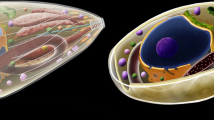Abstract
Trichomonas vaginalis, a flagellated protozoan parasite, is commonly found in the genitourinary tract of humans. Its mode of reproduction has always been reported to be binary fission. The high parasite numbers seen in a relatively short period in in vitro cultures led us to believe that there must be other modes of reproduction. The present study for the first time provides transformational evidence at the ultrastructural level seen in tropohozoites of T. vaginalis undergoing a multiple asexual mode of reproduction. The findings show that the single cell with a nucleus is capable of dividing to as many as eight nuclei within the cytoplasmic body. Before the commencement of division, the nucleus remained round or ovoid in shape with condensed chromatin masses and only a few endoplasmic reticula surrounding the nucleus. During the division, the nucleus started to elongate and become irregular in shape with visible chromatin masses condensing with the accumulation of numerous endoplasmic reticula. Nuclear division gave rise to as many as eight nuclei within a cell, which could be seen to be connected by numerous endoplasmic reticula. In addition, a high number of hydrogenosomes and vacuoles can be seen in multinucleated T. vaginalis compared with single nucleated T. vaginalis. This study confirms that multiple modes of nuclear division do exist in T. vaginalis and are a precursor to progeny formation.





Similar content being viewed by others
References
Benchimol M (2001) Hydrogenosome morphological variation induced by fibronectin and other drugs in Trichomonas vaginalis and Tritichomonas foetus. Parasitol Res 87:215–222
Costamagna SR, Figueroa MP (2001) On the ultrastructure of Trichomonas vaginalis: cytoskeleton, endocytosis and hydrogenosomes. Parasitol día Santiago 25:3–4
Fang ZM, Deng WW, Zhu HG, Yang ZD, Liu JJ (2008) Observation on mitosis of Trichomonas vaginalis cultivated in vitro using modified Giemsa staining. Zhongguo Ji Sheng Chong Xue Yu Ji Sheng Chong Bing Za Zhi 26:397–398
Gelbart SM, Thomason JL, Osypowski PJ, Kellett AV, James JA, Broekhuizen FF (1990) Growth of Trichomonas vaginalis in commercial culture media. J Clin Microbiol 28:962–964
Krieger JN, Alderate JF (1999) Trichomonas vaginalis and trichomoniasis. In: Holmes KK, Mardh P-A, Sparling PF, Lemon SM, Stamm WE, Piot P, Wasserheit JN (eds) Sexually transmitted disease, 3rd edn. McGraw-Hill, New York, pp 1546–1563
Lam CMC, Chong C, Wong JTY (2001) A dinoflagellate mutant with higher frequency of multiple fission. Protoplasma 216:75–79
Peckova H, Lom J (1990) Growth, morphology and division of flagellates of the genus Trypanoplasma (protozoa, kinetoplastida) in vitro. Parasitol Res 76:553–558
Petrin D, Delgaty K, Bhatt R, Garber G (1998) Clinical and microbiological aspects of Trichomonas vaginalis. Clin Microbiol Rev 11:300–317
Rein MF, Queiroz TRBS (2001) Nonintestinal flagellates. In: Guerrant RL, Walker DH, Weller PF (eds) Essentials of tropical infectious diseases. Churchill Livingstone, Philadelphia, p 385
Rein MF, Zenilman J (2000) Trichomoniasis. In: Strickland GT (ed) Hunter’s tropical medicine and emerging infectious diseases, Eighth ed. W.B. Saunders, Philadelphia, pp 610–613
Soper D (2004) Trichomoniasis: under control or undercontrolled? Am J Obstet Gynecol 190:281–290
Stary A, Kuchinka-Koch A, Teodorowicz L (2002) Detection of Trichomonas vaginalis on modified Columbia agar in the routine laboratory. J Clin Microbiol 40:3277–3280
Suresh K, Howe J, Ng GC, Ho LC, Ramachandran NP, Loh AK, Yap EH, Singh M (1994) A multiple fission-like mode of asexual reproduction in Blastocystis hominis. Parasitol Res 80:523–527
Trussell RE (1947) Trichomonas Vaginalis and trichomoniasis. Thomas, Springfield, III. 1st Edition.
WHO (1995) An overview of selected curable sexually transmitted disease. In: Global Program of AIDS. World Health Organization, Geneva, Switzerland, pp 2–27
Acknowledgment
The study would not be possible without the support of UM.C/625/1/HIR/031.
Author information
Authors and Affiliations
Corresponding author
Rights and permissions
About this article
Cite this article
A, Y., S, K. Ultrastructural changes during asexual multiple reproduction in Trichomonas vaginalis . Parasitol Res 110, 1823–1828 (2012). https://doi.org/10.1007/s00436-011-2705-9
Received:
Accepted:
Published:
Issue Date:
DOI: https://doi.org/10.1007/s00436-011-2705-9




